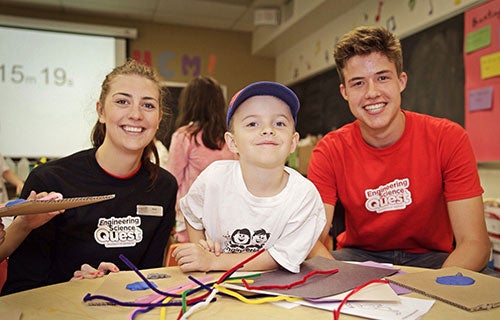
ESQ: Engineering and science outreach program celebrates 25 years
Thousands of children have been inspired by the University of Waterloo’s Engineering Science Quest camps

Thousands of children have been inspired by the University of Waterloo’s Engineering Science Quest camps
By Carol Truemner Faculty of EngineeringFor some, it’s building a wind turbine to harness enough energy to race a car. For others, it’s creating a boat out of cardboard and duct tape. For six-year-old Max Griffiths, there isn’t just one highlight of his first camp experience in 2015 — there are many.
Engineering Science Quest, better known as ESQ, celebrates its 25th anniversary this year. The milestone will be marked July 22 at a breakfast event in Engineering 5’s Sedra Student Design Centre. One of the speakers will be Michelle Miller, who co-founded the ESQ summer camp in the fall of 1990.

Max Griffiths, 6, learns about science and engineering at ESQ summer camp
Miller, a Waterloo chemistry student at the time, came up with the idea of starting ESQ after attending a program at Queen’s University and noticing kids on the Kingston campus wearing engineering and science camp T-shirts. When Miller arrived back at Waterloo, she received approval from the dean of science to work on launching a similar camp as her fourth-year project. She was joined by an engineering student recommended by the dean of engineering at the time.
“We weren’t prepared for the massive amount of work that needed to be done to get ESQ off the ground,” recalls Miller, now a secondary school teacher in Waterloo.
But once the two camps for kids in Grades 5 and 6 launched the following summer, Miller says it was all worthwhile for her and the three other counsellors, one of whom was Laura Matthews, an engineering student.
“We especially loved the aha moments the kids experienced,” she remembers.
A quarter of a century later, the joint outreach program from the Faculties of Science and Engineering, has filled more than 41,000 spots and employed 1,100 staff members, including volunteers.
Today, ESQ offers multiple summer camps on the main Waterloo campus for boys and girls entering Grades 1 to 9. It also offers March break, Winter break, after school and weekend programs, as well as various in-school and community initiatives. Satellite programming is provided in various rural and aboriginal locations throughout Ontario.
Last year, ESQ was awarded the 2013 Actua & GE Canada Award for Leadership and Innovation in science and technology education. The honour recognizes ESQ’s dedication to high-impact quality programs, ongoing leadership and supportive engagement of Canada’s most underserved youth.
Mary Wells, Waterloo Engineering’s associate dean of outreach who has overall responsibility for the program, has the advantage of viewing ESQ through the lens of a parent. Her son and two daughters have attended ESQ camps for a number of years.
“Seeing the camp through their eyes really showed me how valuable it is,” says Wells, the current chair of the Ontario Network of Women in Engineering. “And to a certain degree, it made me believe more strongly in the program.”
When it comes to the success of ESQ over the past 25 years Wells says it’s due to energetic and hard-working staff members, along with the commitment of the University to the program. A large part of that commitment is the new home planned for the outreach department in Engineering 7.
Another testament to the popularity of the program is that Waterloo’s ESQ was the only initiative of its kind to be part of July’s Pan Am games in Toronto. Staff members were onsite for a day engaging hundreds of children in engineering and science activities.

Read more
Here are the people and events behind some of this year’s most compelling Waterloo stories

Read more
Meet the 14 exceptional students representing Waterloo’s newest grads

Read more
GreenHouse awards $10,000 to student ventures and changemakers aiming to transform livelihoods within disadvantaged communities
Read
Engineering stories
Visit
Waterloo Engineering home
Contact
Waterloo Engineering
The University of Waterloo acknowledges that much of our work takes place on the traditional territory of the Neutral, Anishinaabeg, and Haudenosaunee peoples. Our main campus is situated on the Haldimand Tract, the land granted to the Six Nations that includes six miles on each side of the Grand River. Our active work toward reconciliation takes place across our campuses through research, learning, teaching, and community building, and is co-ordinated within the Office of Indigenous Relations.